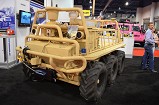On a personal (and testing) note, I prefer the Goodyear Wrangler MTR?s over most other tires on the market. For this article I will refer to the MTR tire, but what I have to say applies to all tires and Jeeps. The test vehicle is a 2004 Jeep Wrangler. |
|
The benefits to airing down are numerous and include the following:
- Bigger surface foot print
- Better ride
- Greater floatation over deep snow, sand and mud
- Improved tire wrap around/grip on the rocks
|
|
This first picture shows the front tires sitting on rocks at 35 psi. I then let the air out of the driver?s side tire at the following levels, 30, 20, 15, 10, and 7 psi. As you can see in the pictures, the tire literally wrapped itself around the rock as the psi decreased.
|

|
Not much of a difference, still not low enough
|

|
Small amount of sidewall flex
|

|
Now your getting into the proper psi
|

|
Here you have a good amount of sidewall flex allowing the tire to wrap
|

|
|
35 psi (left) compared to 7 psi (right)
|

|
So, how much pressure should I have in my tires? Personally I will not go further than 7 psi and normally stay at 15 psi. Why 15 psi? I talked to a Goodyear rep when I was putting on 32x11.5 Goodyear Wrangler MTR?s, and he told me that 15 psi would not hurt the tire or the steel belts.
Note: The lower the psi, the greater the chance of unseating the bead on your rim. If you carry a 12-volt air compressor and a three-inch wide ratchet strap in your emergency tool kit, you can reseat the tire on the trail if this should happen.
|
|
The best time to deflate your tires is when you hit the trail head, and it is important that all your tire pressures are the same. When aired down, your tires have greater traction resulting in more torque being applied to your drive train. In the older CJs and the Wrangler models, the weak point of your Jeep can be the axles. Uneven tire pressure can apply uneven torque and wear to your drive train, which will cause problems on the trail down the road. Additionally, you could have problems engaging and disengaging your lockers. For these reasons, be sure to check tire pressures to ensure they are equal all the way around.
|
|
There are numerous types of air-downs and gauges available off the shelf. Some of them are nicer than others but ultimately they will all work. We strongly suggest that you use the same pressure gauge on ALL your tires. We have found many gauges will very from 1-3 pounds. This variance could create as much as 6 psi difference and many lockers will not like this.
|

|
One of the questions I get asked by newbie Jeepers is, ?What about the sidewall of the tire? Won?t it cut or puncture at a low psi?? There is no guarantee that this will not happen, but the chances of it happening are far less than when running the trail with a fully inflated tire. Think of a balloon. When fully inflated it easily will pop with a pin, but when partially inflated it is harder to pop. One of the reasons I run the Goodyear Wrangler MTR?s is for the great sidewall protection, and Goodyear will replace an MTR if it?s punctured on the trail.
|
|
Have a great summer and enjoy your Jeep. It must be noted that properly maintained tires, as well as the rest of the Jeep, will provide a safe and fun off-road trip. Happy trails!
|
|
 Final Thoughts
MOABJEEPER Magazine would like to point out that the amount of sidewall flex / psi of the tire will vary by brand and size. No one tire pressure will be correct for every application.
Additionally, when choosing the correct psi for your tires keep in mind that the lower you go in psi the lower the vehicle will be thus reducing your ground clearance.
Finally, we suggest when the trail run is over you air your tires back up to the recommended pressure for safe road travel. Traveling with low tire pressure at road/highway speeds could cause tire failure. |
|











